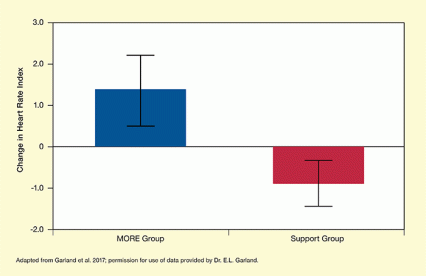This research suggests that:
- Mindfulness-Oriented Recovery Enhancement (MORE) reduces opioid misuse among chronic pain patients.
- MORE shifts patients' attention away from drug cues and toward cues for natural rewards.
Dr. Eric Garland of the University of Utah and colleagues previously demonstrated that mindfulness-oriented treatment can reduce chronic pain patients' misuse of opioids. Now, a follow-up analysis of data from that study tentatively attributes the beneficial effect to an increase in patients' responsiveness to cues for natural rewards relative to cues for drug rewards.
The intervention, called Mindfulness-Oriented Recovery Enhancement (MORE), integrates three techniques. Patients learn and practice:
- Mindfulness—monitoring one's mental experiences without reacting to them. For instance, MORE trains patients to pause before taking pain medications to focus on their thoughts, emotions, bodily sensations, and cravings for opioids. "Through this process, patients learn to distinguish the need to take opioids for pain relief from the drive to take opioids to satisfy craving or to self-medicate in response to negative emotions," Dr. Garland says.
- Reappraisal—viewing stressful events as sources of meaning and personal growth.
- Savoring—focusing on and appreciating pleasure from healthful, beautiful, and life-affirming experiences.
Dr. Garland and colleagues tested MORE in a randomized trial with 115 patients who attended specialty clinics for their chronic pain, most of whom reported opioid misuse. Roughly half of the patients attended weekly group sessions with a social worker who taught and led practice in the MORE techniques and encouraged the patients to practice the techniques daily at home. The remaining patients attended weekly support group sessions that focused on emotional expression and discussion of chronic pain topics. After 8 weeks, the MORE group, in addition to reporting greater reductions in opioid misuse than the support group, reported greater reductions in pain severity and pain-related interference with daily life.
The researchers' follow-up analysis suggests that MORE enabled patients to reduce opioid misuse by increasing their physiological responsiveness to natural-reward cues relative to drug cues. To assess cue responsiveness, the researchers monitored 51 patients' heart rates while showing them pictures of natural rewards (e.g., smiling babies, beautiful landscapes), painful injuries, and opioid pills and pill bottles. Compared with the support group patients, the MORE patients' HR responses to the natural reward cues relative to the drug reward cues increased more from before to after treatment (see Figure). This increase in heart rate responses to natural reward cues compared with drug cues was associated with a decrease in opioid misuse 3 months after the end of treatment, suggesting that MORE may reduce risk for opioid misuse by increasing physiological sensitivity to natural rewards.
Dr. Garland and colleagues continue to research the MORE intervention. They have developed a treatment manual and training protocol for use in health care facilities that will ensure that therapists adhere to the MORE program and deliver it effectively. They also plan to employ MORE in primary care settings, use the intervention to treat veterans and active-duty military personnel, and characterize MORE's impact on the brain with neuroimaging techniques.
Dr. Garland says, "In the future, I hope doctors treating pain patients will prescribe mindfulness-based interventions combined with physical therapy to reduce dependence on opioids, prevent opioid misuse, and potentially even stop acute pain from becoming chronic pain."
This study was supported by NIH grants DA032517 and DA042033.
- Text Description of Figure
The bar chart shows the change in heart rate in response to drug-related and natural reward cues after 8 weeks of MORE intervention or a support group intervention. The horizontal x-axis shows the two treatment groups, with the MORE group on the left and the support group on the right. The vertical y-axis shows the change in heart rate index on a scale from -2.0 to +3.0. Positive values indicate that heart-rate responses to natural reward cues increased relative to heart rate responses to drug-related cues after treatment, whereas negative values indicate that heart-rate responses to natural reward cues decreased relative to heart rate responses to drug-related cues. For the MORE group (blue), the change in heart rate index was approximately +1.3, with a vertical error bar from about +0.5 to about +2.3, indicating increased response to natural rewards. For the support group (red), the change in heart rate index was about -0.9, with a vertical error bar from about -1.4 to about -0.4, indicating decreased response to natural rewards.
Sources:
- Garland, E.L., Howard, M.O., Zubieta, J.-K., et al. Restructuring hedonic dysregulation in chronic pain and prescription opioid misuse: Effects of mindfulness-oriented recovery enhancement on responsiveness to drug cues and natural rewards. Psychotherapy and Psychosomatics 86(2):111-112, 2017.
- Garland, E.L., Manusov, E.G., Froeliger, B., et al. Mindfulness-oriented recovery enhancement for chronic pain and prescription opioid misuse: results from an early stage randomized controlled trial. J Consult Clin Psychol 82(3): 448-459, 2014.

